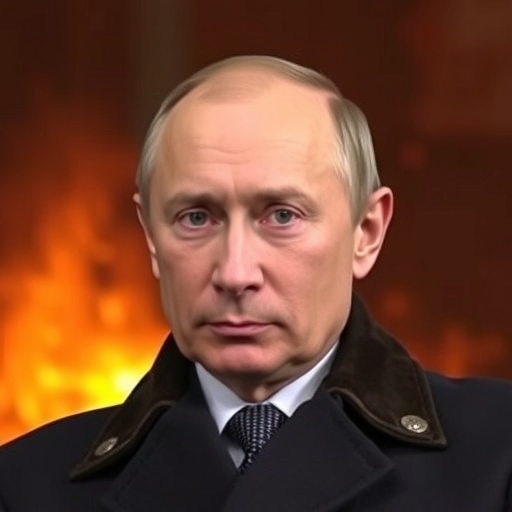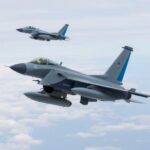Putin’s War Machine Choked: Coalition Urges Global Ban on Russian Oil to Starve Ukraine Conflict Funding
In a bold escalation of international pressure, leaders from a newly formed ‘Coalition of the Willing’ have declared war on Russia‘s economic lifelines, vowing to eradicate Russian oil and gas from global markets to cripple Vladimir Putin’s funding for the ongoing invasion of Ukraine. This dramatic push, announced at a high-stakes summit in Brussels, signals a unified front against Moscow’s aggression, with promises of sweeping new oil sanctions that could slash billions from Russia‘s war chest.
- Coalition Forms Ironclad Alliance Against Russian Energy Dominance
- New Sanctions Target Putin’s Revenue Streams in Ukraine War
- Military Support Surge Bolsters Ukraine’s Defense Against Russian Advances
- Global Energy Realignment Challenges Russian Oil Supremacy
- Path Forward: Enforcing Sanctions and Sustaining Pressure on Putin
The coalition, comprising key allies including the United States, European Union nations, Japan, and Australia, emphasized that removing Russian energy exports isn’t just an economic tactic—it’s a moral imperative to end the bloodshed in Ukraine. “We cannot allow Putin’s regime to profit from the very resources that fuel his barbaric war,” declared U.S. President Joe Biden during the summit’s opening remarks, underscoring the emotional toll of the conflict that has claimed tens of thousands of lives since February 2022.
With Russian oil revenues already down 40% from pre-war levels due to existing sanctions, this new initiative aims to drive that figure even lower, potentially forcing Putin to confront the financial unsustainability of his military campaign. Experts warn that such measures could accelerate Russia‘s economic isolation, but they also highlight the risks of global energy disruptions in an already volatile market.
Coalition Forms Ironclad Alliance Against Russian Energy Dominance
The ‘Coalition of the Willing’ emerged from urgent talks amid reports of intensified Russian assaults on Ukrainian cities, including recent drone strikes on Kyiv that killed at least 12 civilians. Comprising over 20 nations, the group represents more than 60% of global GDP and is positioning itself as a counterweight to Russia’s alliances with nations like China and India, which have continued purchasing discounted Russian oil.
European Commission President Ursula von der Leyen, a key architect of the coalition, outlined the plan in vivid detail: “Our strategy is clear—choke the pipelines of war. By coordinating oil sanctions and accelerating the shift to alternative energy sources, we will deny Putin the billions he needs to sustain his invasion of Ukraine.” The coalition’s charter, signed by representatives from NATO allies and Indo-Pacific partners, commits members to a phased ban on Russian crude and refined products, starting with a 90-day grace period for rerouting supplies.
Historical context underscores the urgency. Since the full-scale invasion began, Russia has exported over 7.5 million barrels of oil per day, generating an estimated $300 billion in revenue in 2023 alone, according to data from the International Energy Agency (IEA). Much of this has funded advanced weaponry and troop deployments in Ukraine, where Russian forces now control about 18% of the country’s territory. The coalition’s move builds on previous efforts, like the EU’s 2022 embargo on seaborne Russian oil, which forced Moscow to sell at steep discounts—sometimes up to 30% below market rates.
But the new push goes further. Japan, a major importer of Russian liquefied natural gas (LNG), pledged to reduce its intake by 50% by 2025, while Australia announced incentives for domestic LNG production to fill the gap. “This is about collective resolve,” said Australian Prime Minister Anthony Albanese. “We stand with Ukraine not just in words, but by hitting Russia where it hurts most—its wallet.”
New Sanctions Target Putin’s Revenue Streams in Ukraine War
At the heart of the coalition’s strategy are targeted oil sanctions designed to dismantle Russia’s shadow fleet of tankers, which has evaded Western restrictions by using opaque shipping routes and third-party flags. The U.S. Treasury Department revealed plans to sanction over 100 vessels and entities involved in these operations, potentially freezing $10 billion in assets and halting 2 million barrels per day of illicit trade.
Putin’s response has been defiant, with Kremlin spokespeople labeling the moves “economic terrorism.” Yet, internal Russian documents leaked to Western media suggest mounting pressure: oil revenues, which account for 40% of the federal budget, dropped to $180 billion in the first half of 2024, a 25% decline year-over-year. This squeeze is already manifesting on the battlefield, where Ukrainian forces report delays in Russian ammunition supplies, possibly linked to budgetary constraints.
Quotes from the front lines add a human dimension. Ukrainian President Volodymyr Zelenskyy, addressing the summit virtually from a bunker in Kyiv, implored: “Every barrel of Russian oil sold funds the missiles raining on our homes. The coalition’s action today could be the turning point that saves lives and restores peace.” His words resonated, prompting immediate commitments: the UK vowed an additional $500 million in sanctions enforcement, while Canada announced a ban on all Russian energy imports effective immediately.
Economically, the sanctions could exacerbate Russia’s inflation, currently at 8.5%, and deepen its reliance on wartime spending, which has ballooned to 6% of GDP. Analysts from the Brookings Institution estimate that a full market exclusion could reduce Russia’s export earnings by another $100 billion annually, forcing Putin to dip into gold reserves or seek unsustainable loans from allies like Iran.
- Key Sanction Components: Price caps on Russian oil extended to $45 per barrel (down from $60).
- Prohibition on insurance for Russian-flagged tankers by Western firms.
- Joint task force to monitor and intercept shadow fleet vessels in international waters.
These measures, if enforced rigorously, could mirror the impact of the 2014 Crimea sanctions, which initially slowed Russian GDP growth by 2-3 percentage points.
Military Support Surge Bolsters Ukraine’s Defense Against Russian Advances
Parallel to the economic offensive, the coalition is ramping up military aid to Ukraine, with pledges totaling $50 billion in new weaponry and training programs. This includes advanced F-16 fighter jets from the Netherlands and Denmark, expected to arrive by early 2025, and long-range ATACMS missiles from the U.S., capable of striking deep into occupied territories.
The timing is critical as Russian forces, bolstered by North Korean troops according to U.S. intelligence, push toward key Donbas cities like Pokrovsk. Ukrainian military officials report that enhanced air defenses, funded by coalition contributions, have intercepted 85% of incoming drones in recent weeks, a stark improvement from the war’s early days.
“Putin’s war machine is faltering not just financially, but operationally,” said NATO Secretary General Jens Stoltenberg. “Our support ensures Ukraine can hold the line while we starve the aggressor of resources.” The coalition also unveiled a $10 billion fund for Ukraine’s reconstruction, conditional on progress toward EU membership, blending immediate defense needs with long-term stability.
Statistics paint a grim picture of the conflict’s toll: Over 500,000 casualties on both sides, 6 million Ukrainian refugees, and infrastructure damage estimated at $150 billion. Yet, coalition aid has enabled Ukraine to reclaim 50% of initially lost territory through counteroffensives, including the daring incursion into Russia’s Kursk region in August 2024.
- U.S. Contribution: $20 billion in munitions and intelligence sharing.
- EU Package: €15 billion for artillery shells and cyber defenses.
- Asia-Pacific Allies: Japan and South Korea provide $5 billion in non-lethal aid, including drones and medical supplies.
This multifaceted support aims to deter further Russian escalation, such as threats of nuclear saber-rattling, which Putin has invoked amid battlefield setbacks.
Global Energy Realignment Challenges Russian Oil Supremacy
As the coalition moves to excise Russian energy from the market, the world grapples with a seismic shift in supply chains. The IEA projects that non-Russian oil production, led by Saudi Arabia, the U.S., and Brazil, can cover 95% of the shortfall, with U.S. shale output hitting record highs of 13.5 million barrels per day.
Europe, once 40% dependent on Russian gas, has diversified aggressively: LNG imports from the U.S. and Qatar surged 60% in 2023, while renewable energy capacity grew by 25%. “We’re not just sanctioning Russia; we’re reinventing our energy future,” noted German Chancellor Olaf Scholz, who championed a €100 billion green transition fund within the coalition.
However, challenges loom. India’s continued purchases of Russian oil—up 20% this year—pose a loophole, prompting the coalition to engage New Delhi in diplomatic talks. China, Russia’s largest buyer, remains a wildcard, absorbing 2 million barrels daily at discounts. Economists warn of short-term price spikes, with Brent crude potentially reaching $90 per barrel, but long-term benefits include accelerated decarbonization.
In Ukraine, the energy war hits home: Russian strikes have destroyed 50% of the country’s power generation capacity, leaving millions in the dark. Coalition pledges include $2 billion for solar and wind projects to rebuild resilient infrastructure, symbolizing hope amid devastation.
Path Forward: Enforcing Sanctions and Sustaining Pressure on Putin
Looking ahead, the coalition’s success hinges on enforcement and adaptability. A dedicated monitoring body, headquartered in Warsaw, will track compliance, with penalties for members who falter. Diplomatic outreach to neutral states like Turkey and the UAE aims to close sanction evasion routes, potentially involving UN resolutions for broader legitimacy.
For Putin, the implications are stark: Diminished revenues could force troop reductions or negotiations, especially as domestic unrest simmers—polls show 20% of Russians now oppose the war. Ukraine’s path to victory grows clearer with sustained aid, but experts caution that winter offensives and hybrid threats like cyberattacks demand vigilance.
The coalition’s resolve signals a new era of global solidarity against aggression. As Zelenskyy put it, “This is more than sanctions; it’s a stand for freedom.” With markets watching and battlefields shifting, the coming months will test whether these measures can truly choke Putin’s ambitions and pave the way for peace in Ukraine.









